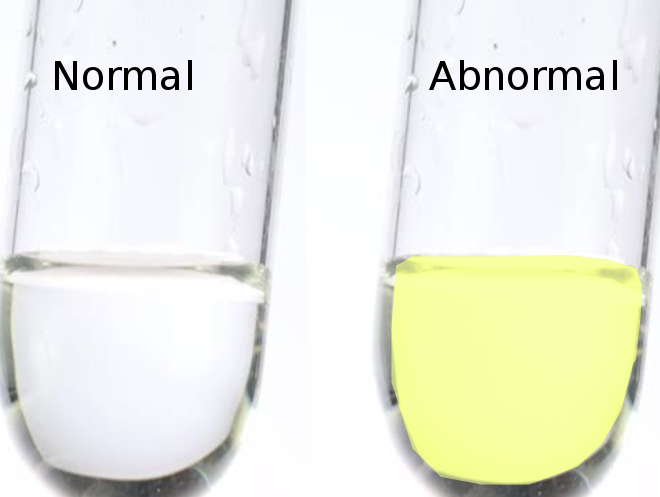[1]
Shah KH, Edlow JA. Distinguishing traumatic lumbar puncture from true subarachnoid hemorrhage. The Journal of emergency medicine. 2002 Jul:23(1):67-74
[PubMed PMID: 12217474]
[2]
Seehusen DA, Reeves MM, Fomin DA. Cerebrospinal fluid analysis. American family physician. 2003 Sep 15:68(6):1103-8
[PubMed PMID: 14524396]
[3]
Chu KH, Bishop RO, Brown AF. Spectrophotometry, not visual inspection for the detection of xanthochromia in suspected subarachnoid haemorrhage: A debate. Emergency medicine Australasia : EMA. 2015 Jun:27(3):267-72. doi: 10.1111/1742-6723.12398. Epub 2015 Apr 28
[PubMed PMID: 25919441]
[4]
Gill HS, Marcolini EG, Barber D, Wira CR. The Utility of Lumbar Puncture After a Negative Head CT in the Emergency Department Evaluation of Subarachnoid Hemorrhage. The Yale journal of biology and medicine. 2018 Mar:91(1):3-11
[PubMed PMID: 29599652]
[5]
Long B, Koyfman A, Runyon MS. Subarachnoid Hemorrhage: Updates in Diagnosis and Management. Emergency medicine clinics of North America. 2017 Nov:35(4):803-824. doi: 10.1016/j.emc.2017.07.001. Epub 2017 Aug 24
[PubMed PMID: 28987430]
[6]
Rankin S, McGuire J, Chekroud M, Alakandy L, Mukhopadhyay B. Evaluating xanthochromia in the diagnosis of subarachnoid haemorrhage in Scotland in the Era of modern computed tomography. Scottish medical journal. 2022 May:67(2):71-77. doi: 10.1177/00369330211072264. Epub 2022 Feb 1
[PubMed PMID: 35105220]
[7]
Ichiba T, Hara M, Nishikawa K, Tanabe T, Urashima M, Naitou H. Comprehensive Evaluation of Diagnostic and Treatment Strategies for Idiopathic Spinal Subarachnoid Hemorrhage. Journal of stroke and cerebrovascular diseases : the official journal of National Stroke Association. 2017 Dec:26(12):2840-2848. doi: 10.1016/j.jstrokecerebrovasdis.2017.07.003. Epub 2017 Aug 9
[PubMed PMID: 28802522]
[8]
Yu SD, Chen MY, Johnson AJ. Factors associated with traumatic fluoroscopy-guided lumbar punctures: a retrospective review. AJNR. American journal of neuroradiology. 2009 Mar:30(3):512-5. doi: 10.3174/ajnr.A1420. Epub 2009 Jan 15
[PubMed PMID: 19147709]
Level 2 (mid-level) evidence
[9]
UK National External Quality Assessment Scheme for Immunochemistry Working Group. National guidelines for analysis of cerebrospinal fluid for bilirubin in suspected subarachnoid haemorrhage. Annals of clinical biochemistry. 2003 Sep:40(Pt 5):481-8
[PubMed PMID: 14503985]
Level 2 (mid-level) evidence
[10]
Bazer DA, Koroneos N, Orwitz M, Amar J, Corn R, Wirkowski E. The Diagnostic Dilemma in Delayed Subarachnoid Hemorrhage: A Case Report. Clinical practice and cases in emergency medicine. 2023 Aug:7(3):175-177. doi: 10.5811/cpcem.1586. Epub
[PubMed PMID: 37595310]
Level 3 (low-level) evidence
[11]
Vermeulen M, Hasan D, Blijenberg BG, Hijdra A, van Gijn J. Xanthochromia after subarachnoid haemorrhage needs no revisitation. Journal of neurology, neurosurgery, and psychiatry. 1989 Jul:52(7):826-8
[PubMed PMID: 2769274]
[12]
Chakraborty T, Daneshmand A, Lanzino G, Hocker S. CT-Negative Subarachnoid Hemorrhage in the First Six Hours. Journal of stroke and cerebrovascular diseases : the official journal of National Stroke Association. 2020 Dec:29(12):105300. doi: 10.1016/j.jstrokecerebrovasdis.2020.105300. Epub 2020 Oct 10
[PubMed PMID: 33051138]
[13]
Petzold A, Keir G, Sharpe LT. Spectrophotometry for xanthochromia. The New England journal of medicine. 2004 Oct 14:351(16):1695-6
[PubMed PMID: 15483297]
[14]
Petzold A, Keir G, Sharpe TL. Why human color vision cannot reliably detect cerebrospinal fluid xanthochromia. Stroke. 2005 Jun:36(6):1295-7
[PubMed PMID: 15879320]
[15]
Moore SA, Rabinstein AA, Stewart MW, David Freeman W. Recognizing the signs and symptoms of aneurysmal subarachnoid hemorrhage. Expert review of neurotherapeutics. 2014 Jul:14(7):757-68. doi: 10.1586/14737175.2014.922414. Epub
[PubMed PMID: 24949896]
[16]
Abraham MK, Chang WW. Subarachnoid Hemorrhage. Emergency medicine clinics of North America. 2016 Nov:34(4):901-916. doi: 10.1016/j.emc.2016.06.011. Epub
[PubMed PMID: 27741994]
[17]
Dupont SA, Wijdicks EF, Manno EM, Rabinstein AA. Thunderclap headache and normal computed tomographic results: value of cerebrospinal fluid analysis. Mayo Clinic proceedings. 2008 Dec:83(12):1326-31. doi: 10.1016/S0025-6196(11)60780-5. Epub
[PubMed PMID: 19046551]
[18]
Mark DG, Kene MV, Offerman SR, Vinson DR, Ballard DW, Kaiser Permanente CREST Network. Validation of cerebrospinal fluid findings in aneurysmal subarachnoid hemorrhage. The American journal of emergency medicine. 2015 Sep:33(9):1249-52. doi: 10.1016/j.ajem.2015.05.012. Epub 2015 May 15
[PubMed PMID: 26022754]
Level 1 (high-level) evidence
[19]
de Oliveira Manoel AL, Goffi A, Marotta TR, Schweizer TA, Abrahamson S, Macdonald RL. The critical care management of poor-grade subarachnoid haemorrhage. Critical care (London, England). 2016 Jan 23:20():21. doi: 10.1186/s13054-016-1193-9. Epub 2016 Jan 23
[PubMed PMID: 26801901]
[21]
Wisborg T. [Overuse of CT at the trauma centre?]. Tidsskrift for den Norske laegeforening : tidsskrift for praktisk medicin, ny raekke. 2019 Mar 12:139(5):. doi: 10.4045/tidsskr.19.0038. Epub 2019 Mar 11
[PubMed PMID: 30872827]
[22]
Ohana O, Soffer S, Zimlichman E, Klang E. Overuse of CT and MRI in paediatric emergency departments. The British journal of radiology. 2018 May:91(1085):20170434. doi: 10.1259/bjr.20170434. Epub 2018 Feb 5
[PubMed PMID: 29271231]
[23]
Martin SC, Teo MK, Young AM, Godber IM, Mandalia SS, St George EJ, McGregor C. Defending a traditional practice in the modern era: The use of lumbar puncture in the investigation of subarachnoid haemorrhage. British journal of neurosurgery. 2015:29(6):799-803. doi: 10.3109/02688697.2015.1084998. Epub 2015 Sep 16
[PubMed PMID: 26373397]
[24]
Chu K, Hann A, Greenslade J, Williams J, Brown A. Spectrophotometry or visual inspection to most reliably detect xanthochromia in subarachnoid hemorrhage: systematic review. Annals of emergency medicine. 2014 Sep:64(3):256-264.e5. doi: 10.1016/j.annemergmed.2014.01.023. Epub 2014 Mar 11
[PubMed PMID: 24635988]
Level 1 (high-level) evidence
[25]
Goyale A, O'Shea J, Marsden J, Keep J, Vincent RP. Analysis of cerebrospinal fluid for xanthochromia versus modern computed tomography scanners in the diagnosis of subarachnoid haemorrhage: experience at a tertiary trauma referral centre. Annals of clinical biochemistry. 2016 Jan:53(Pt 1):150-4. doi: 10.1177/0004563215579454. Epub 2015 Mar 12
[PubMed PMID: 25766384]
[26]
Nagy K, Skagervik I, Tumani H, Petzold A, Wick M, Kühn HJ, Uhr M, Regeniter A, Brettschneider J, Otto M, Kraus J, Deisenhammer F, Lautner R, Blennow K, Shaw L, Zetterberg H, Mattsson N. Cerebrospinal fluid analyses for the diagnosis of subarachnoid haemorrhage and experience from a Swedish study. What method is preferable when diagnosing a subarachnoid haemorrhage? Clinical chemistry and laboratory medicine. 2013 Nov:51(11):2073-86. doi: 10.1515/cclm-2012-0783. Epub
[PubMed PMID: 23729569]
